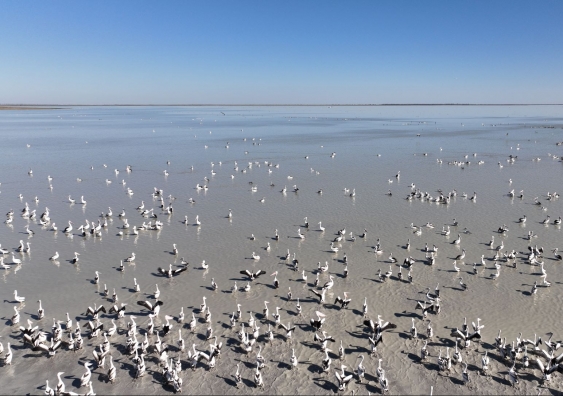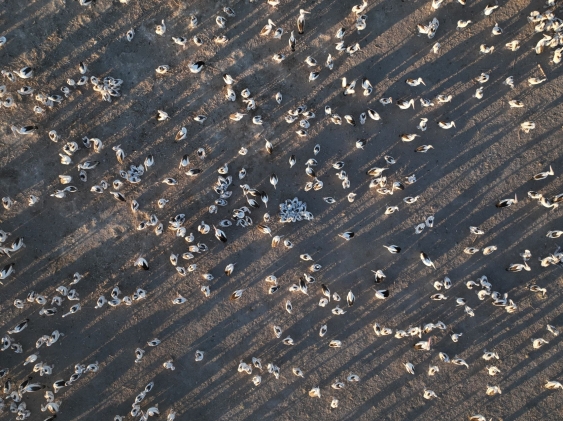Pelicans breed at north-western NSW's Narran Lakes for the first time in over 20 years
A research team at UNSW Sydney has been monitoring water bird breeding events in real time for the last four months.
A research team at UNSW Sydney has been monitoring water bird breeding events in real time for the last four months.

Jane Howard
0422 374 804
janehowardmarketing@gmail.com
Recent flows, including water for the environment, have led to waterbirds breeding at the Ramsar-protected Narran Lakes (also known as Dharriwaa) for only the second time in 10 years. This season’s cohort included two Australian Pelican colonies, a species that has not bred at the site since the 1990s.
UNSW Sydney Centre for Ecosystem Science's Senior Research Fellow Dr Kate Brandis and her team are working on behalf of the Commonwealth Environmental Water Holder (CEWH) to monitor the NSW waterbird breeding events. Monitoring included studying the size of the colonies, reproductive successes and failures, and water depth and quality.
“My research team and those from the NSW Department of Planning and Environment have been monitoring Narran Lakes and Macquarie Marshes every two weeks since November last year,” Dr Brandis said.
“We monitor whether the birds successfully breed to completion, which involves studying how many eggs successfully become chicks and how many of these chicks become juvenile birds that can leave the wetland and contribute to the larger population.
“Throughout the monitoring, we also study water depth which is essential for the bird breeding to make it to completion. If water levels rise too quickly nests become flooded, and if water levels fall too fast it reduces food availability and increases vulnerability to predators, and the likelihood of adults abandoning nests,” she said.
The real-time monitoring of the breeding events provides the CEWH and NSW Environmental Water Managers with essential information for water flow management decision-making during breeding events, to ensure the chicks have every chance of survival.
The monitoring at Narran Lakes helped inform the CEWH’s recent decision to release water into the wetland via the Narran River to help maintain the bird breeding conditions.

Monitoring of waterbird populations included studying how many eggs successfully become chicks and how many of these chicks become juvenile birds. Photo: Shot by Harro for UNSW.
CEWH's Dr Simon Banks said a recent agreement with a private landholder on the Narran River has seen additional water flow to Narran Lakes to support bird breeding.
“I was at Narran Lakes recently with Dr Brandis to see the waterbird breeding colonies first-hand. It was fantastic to see water for the environment maintaining the wetland and contributing to the successful completion of bird breeding.
“Waterbird populations have declined significantly along eastern Australia since the 1980s, making successful breeding events at Narran Lakes, Macquarie Marshes and other wetlands in the Murray-Darling Basin essential to helping replenish bird numbers,” he said.
The research team estimates there have been around 5000 breeding pairs of Australian Pelicans at Narran Lakes along with several thousand breeding pairs of other waterbirds including Straw-necked Ibis, Royal Spoonbills, Glossy Ibis, Egrets, Cormorants and Australasian Darters.
Included in the 5000 pairs of Australian Pelicans were two pelicans that had been leg-banded in the Lachlan River catchment as part of the Lake Brewster Banding Project, meaning the birds had made a journey of more than 400 kilometres.
Macquarie Marshes also saw large Ibis and Egret colonies successfully breed from September 2022 to March 2023.